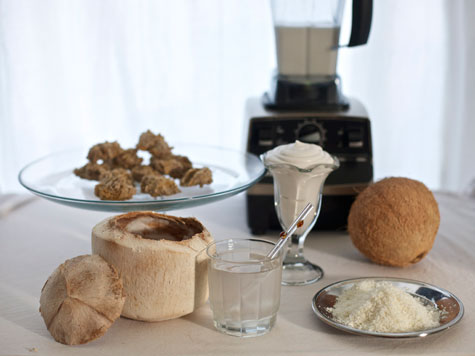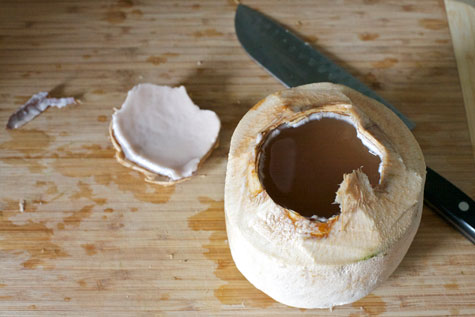 Coconut diversity! From left to right: macaroons, young Thai coconut, fresh young coconut water, cultured coconut yogurt, blended coconut milk, dried shredded coconut “meat”, whole mature coconut.
Coconut diversity! From left to right: macaroons, young Thai coconut, fresh young coconut water, cultured coconut yogurt, blended coconut milk, dried shredded coconut “meat”, whole mature coconut.
Did you know that coconuts are freaking fantastic? It’s true! They’re one of my absolute favorite foods, for two main reasons. First, their nutritional profile is outstanding and quite unique. Secondly, their diversity is practically unparalleled. You can do so many different things with coconuts! And the great news is that their popularity is on the rise, which means they’re becoming available in more and more forms, at more and more locations.
Before we get into the nitty gritty, let’s begin with a simple introduction:

Coconuts are not actually nuts; they’re the fruit of the coconut palm and they contain a single seed. This is confusing, since “nut” is in the name, and even more so because the United States FDA has categorized them as a nut for allergy purposes. Because of this, coconuts must be disclosed under the allergy warning on packaged goods. Interestingly, in areas of the world where coconuts are a prominent part of the diet, they compose a large percentage of food allergies (in the top 5). But in places like the US, the UK, and Australia, coconut allergies are virtually nonexistent. Aside from all that, the takeaway is that coconuts are mostly a fruit . . . with an edible seed . . . so sort of both, but not a nut . . . okay, they’re really in a class all their own. As you’ll see!
Coconuts play a major role in many equatorial cultures. In much of the world, they are eaten daily and provide a major source of calories and nutrients. In the Philippines, the coconut palm is referred to as “The Tree Of Life”. Undoubtedly, coconuts are a traditional food with a long history of human use.
The ancient food forms of coconut include:
Young Flesh, raw – soft and gelatinous, sparse
Mature Flesh, raw – harder and more abundant
Mature Flesh, dried – also called “copra”, used in cooking and used to make oil
The Water – actually liquid endosperm (the “meat”), contains protein, vitamins, and minerals, in isotonic electrolyte balance.
The Milk – produced by mixing hot water with grated flesh (fresh or copra) to draw out the oils and flavors. High fat content and will separate into cream if left in cool temperature.
The Oil – extracted from mature meat, can be cold-pressed (raw) or heat/solvent-extracted (not raw, more processed). Very heat stable, with a high smoke point, making it excellent for frying and other high-temperature cooking.
Palm Sugar/Jaggery – sap is collected from the palm flowers and heated until it reduces and dries out. Used as a sweetener, tastes like earthy brown sugar.
Hearts of Palm – the apical buds of adult plants. Did you know that harvesting them in the wild actually kills the plants?
So, why are coconuts so damn awesome? Well, let me tell you.
 Raw cultured coconut yogurt parfait with chocolate rye gRAWnola and fresh strawberries. Recipes in Rawsomely Vegan.
Raw cultured coconut yogurt parfait with chocolate rye gRAWnola and fresh strawberries. Recipes in Rawsomely Vegan.
Coconut is lower in sugar and higher in protein than other typical fruits. It’s also high in fiber and important phytochemicals, such as phenolic acids. Coconut contains significant vitamin E, and the minerals iron, phosphorous, and zinc. Coconut oil also has impressive antimicrobial properties (1), including as an effective treatment for Candida (2).
Coconut contains a very high percentage of fat. Of the fats found in coconut, about 90% are saturated. “Eeek!” you might be saying. “But isn’t saturated fat, like zee deveel?” Well, maybe not!
Lauric acid is the fatty acid that comprises 50% of the total fats found in coconut. Lauric acid, along with many of the other coconut fats, is a rare medium-chain fatty acid. It also happens to be one of the major components of human breast milk! And there is some evidence, which I’ll discuss below, that these plant-based medium-chain fatty acids do not carry the same risks associated with other saturated fats.
Just to be clear: many doctors, governmental agencies, and the World Health Organization, recommend against consuming a lot of coconut, and especially coconut oil. This is exclusively because of the high saturated fat content, and ignores the fact that there are different types of saturated fat. Early studies on coconut oil indicated a deleterious effect, but these studies were all conducted using partially-hydrogenated coconut oil. That’s trans fat! Obviously, an artificially processed oil “product” can not fairly be compared to minimally processed natural coconut foods.
As noted above, in many parts of the world coconuts are eaten daily and provide the vast majority of dietary fat. In these same regions the risk of chronic disease, including coronary heart disease, is exceptionally low (3) (4) (5). However, these data disintegrate as soon as the culture shifts from their traditional diet (high in plant foods and fiber) to a western diet (including processed foods, refined grain, dairy, and sugar). As always, the protective effect of foods work synergistically within the context of the entire diet, and a singe element cannot be isolated and extracted.
So what about that saturated fat? Should it be a concern?
Well, it sort of depends on the rest of your diet. Coconut oil does in fact raise cholesterol. However, it raises the “good” cholesterol more than the “bad”, which actually results in a preferred lipid profile (6) (7). For some populations, like those eating a plant-strong diet, coconut may be especially beneficial when used as a tool to maintain optimal cholesterol levels. Cholesterol is essential for hormone regulation and other metabolic functions, and a cholesterol number than drops too low can actually become detrimental.
 Raw cacao-dipped orange coconut macaroons. Recipes in Rawsomely Vegan.
Raw cacao-dipped orange coconut macaroons. Recipes in Rawsomely Vegan.
So what’s the bottom line? I believe that in a plant-strong, whole foods diet – in my diet – coconut oil is an awesome, health-promoting food. I think that if somebody is eating a diet that’s rich in animal proteins, animal-sourced saturated fat, and dietary cholesterol, than coconut oil may not be the best choice . . . but really, then coconut oil is probably the least of their worries!
There are people who will tell you that coconut is some sort of magical superfood; that it can do everything from preventing seizures to killing the AIDS virus. (seriously) Um, I’m not one of those people! What I am telling you, is that using coconut foods to replace other products is a positive step towards optimal wellness. Coconuts are exceptionally healthful as compared to their alternatives. They allow for culinary creativity and a whole new realm of plant-based rich and creamy dishes, from wholesome entrées to decadent desserts.
Along with the traditional preparations, there are a number of modern coconut foods, including:
Flour – made from the dried flesh once the oil has been pressed out
Nectar – the sap from the flowers
Crystals – sap, dehydrated at low temperature
Palm Wine – fermented sap
Aminos – aged and salted sap
Vinegar – fermented coconut water
Butter – the meat pureed together with the oil
. . . but we’ll have to talk about those another time.
And what about you my dears? Do you use coconut foods? If so, how? If not, do you want to try them?





Pingback: time for a motivational revue! |
Pingback: Thai Coconut-Baked Tofu « Farmers Market Vegan
Pingback: Sweet Freedom | Earth Friendly Planet
Pingback: Ani’s Raw Food Desserts | Earth Friendly Planet
Pingback: Becoming Raw | Earth Friendly Planet
Pingback: Facing Failing Health On A Vegan Diet | Bonzai Aphrodite